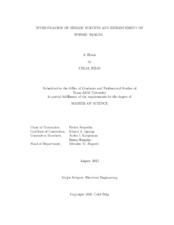| dc.contributor.advisor | Serpedin, Erchin | |
| dc.contributor.advisor | Qaraqe, Khalid | |
| dc.creator | Bilgi, Celal | |
| dc.date.accessioned | 2015-10-29T19:40:31Z | |
| dc.date.available | 2015-10-29T19:40:31Z | |
| dc.date.created | 2015-08 | |
| dc.date.issued | 2015-06-05 | |
| dc.date.submitted | August 2015 | |
| dc.identifier.uri | https://hdl.handle.net/1969.1/155446 | |
| dc.description.abstract | The ability to recover a seismic image of subsurface structure from recorded seismic data plays an important role in exploration of seismology applications. Processing techniques are applied to recover the geology from data recorded in the field. Complexity of the geology and processing time decide which processing technique should be utilized.
Seismic imaging is achieved via two steps: 1) generating the seismic data from geology and 2) recovering the geology structure from the generated data. For the first step, a forward modeling technique is employed to generate seismic data on computers similarly to the field experiments. The forward modeling uses a priorly known velocity model as geology. The position of seismic components is priorly set and forward modeling is applied. The outcomes of this operation are seismic wave fields and data gathers.
The second step is necessary to recover the geologic information from the outcomes of the forward modeling. Migration techniques are used. Many practical migration algorithms exist to handle the seismic imaging problem. The important part is choosing the right algorithm depending on the complexity of the geology. One of the most common technique, referred to as Kirchhoff Migration, and state-of-the-art technique Reverse Time Migration are considered.
The purpose of this thesis is to provide an incursion into the field of reflection seismology by investigating the migration techniques and assessing their accuracy at subsurface imaging and enhancement the final image obtained from migration operations. This thesis focuses on the enhancement of the resolution of the final migrated seismic image. The proposed idea is to apply both Butterworth band-pass filter and Laplacian filter to get a better resolution of the image. Butterworth bandpass filter eliminates unwanted frequency components in the Fourier domain and the Laplacian filter highlights the rapid changes to show reflection points. Furthermore, the migrated and filtered final seismic image yields better results of geology of the area of interest. | en |
| dc.format.mimetype | application/pdf | |
| dc.language.iso | en | |
| dc.subject | reflection seismology | en |
| dc.subject | migration | en |
| dc.subject | filtering | en |
| dc.title | Investigation of Seismic Surveys and Enhancement of Seismic Images | en |
| dc.type | Thesis | en |
| thesis.degree.department | Electrical and Computer Engineering | en |
| thesis.degree.discipline | Electrical Engineering | en |
| thesis.degree.grantor | Texas A & M University | en |
| thesis.degree.name | Master of Science | en |
| thesis.degree.level | Masters | en |
| dc.contributor.committeeMember | Hascakir, Berna | |
| dc.contributor.committeeMember | Karsilayan, Aydin | |
| dc.type.material | text | en |
| dc.date.updated | 2015-10-29T19:40:31Z | |
| local.etdauthor.orcid | 0000-0002-9901-2217 | |


